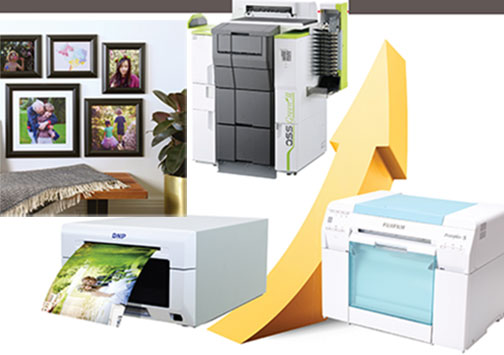
Digital photography is a worldwide phenomenon. Smartphones, social media and consumers’ appetite for visual communication are all driving the demand for more images. The Pew Research Center reports that roughly three-quarters of Americans own a smartphone. In addition, 92% of young people 18 to 29 carry a cameraphone. A report by F/22 Consulting and Photo Imaging News, Expanding the U.S. Photo Printing Market,* estimates that Americans captured 1.2 trillion images in 2016.
In total, 85% were taken with smartphones. These captures translated to 176 million print orders as well as 8.2 billion printed units, including prints, wall art, photo books and personalized gifts. 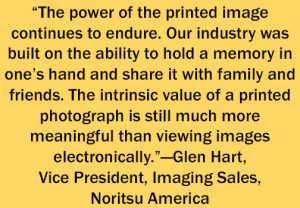 “The number and quality of photos captured today (especially on smartphones) is nothing short of staggering. And it’s a global phenomenon,” says the recently published analysis by Don Franz and Frank Baillargeon. “Mobile adoption, equally staggering advances in intelligent and automated photo management, and new mobile photo printing business models represent an unprecedented foundation for substantial and sustained growth of demand.”
“The number and quality of photos captured today (especially on smartphones) is nothing short of staggering. And it’s a global phenomenon,” says the recently published analysis by Don Franz and Frank Baillargeon. “Mobile adoption, equally staggering advances in intelligent and automated photo management, and new mobile photo printing business models represent an unprecedented foundation for substantial and sustained growth of demand.”
What does this surge in digital capture mean for the photo printing industry? For companies on the front line of digital print fulfillment, the numbers are good.
Fujifilm North America Corporation
Fujifilm has been on the pioneering end of digital delivery since the late 1990s. “We were the first company to develop and implement a distribution fulfillment system that allowed consumers to order their prints online and pick them up in the store,” says Manny Almeida, president, Imaging Division, Fujifilm North America Corporation.

“The U.S. market saw its peak in photo printing in 2003,” he says. “There were 860 million rolls of film sold that year, with an average of 27 prints per roll. That’s almost 19 billion prints. Today, the print market is certainly not that big. But the print category is still $1.5 billion, and the decline is beginning to plateau. At one time, prints were declining at a rate of 30% per year. Over the last year or two, it’s been declining at 3.5%. So it’s really starting to flatten out.
“Printing is different today,” adds Almeida. “There’s a myriad of personalized photo products; over 400 different products available from Fujifilm alone. So while orders for 4×6-inch prints are down, overall printing is up. We have higher value orders. An average order 15 years ago would be in the $8 to $9 range, today it’s around $24.
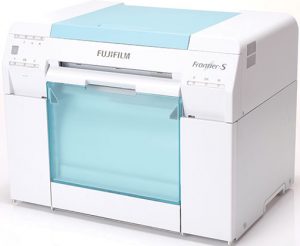
“The important part for us at Fujifilm is that there is opportunity in photo printing. It’s not like it was 15 or 20 years ago. It’s a different opportunity but still a tremendous opportunity. People don’t necessarily want to print a whole bunch of 4×6 prints, but they want to create photo products such as wall décor and products they can give as gifts. The printing industry is about figuring out what consumers want and how they want it.”
Photomore, Peleman Industries
Photomore, a Peleman Industries operating group, is a top manufacturer of equipment and supplies for in-store photo book production, mounted prints and also finishing products. Like many value-added photo gift manufacturers, Photomore has seen a significant increase in product demand.
“We’ve definitely seen a spike in all our photo products,” says Brigitte Peleman-Vantieghem, CEO, Peleman Industries USA. “We’ve seen a spike in the single print category, where people can choose one picture and get a beautifully finished print, ready for hanging or flat surface display, in an hour. There’s also been a shift in the photo book segment. Based on Futuresource Consulting data, customers are beginning to move from online purchases to ordering photo books in-store, and also ordering online and picking up their photo books in-store.”

Peleman’s Photomore group offers various photo book options: self-adhesive photo books that are assembled by peeling and sticking prints onto the pages; and UniClamp, hardcover and softcover photo books that are printed and assembled in-store. The company’s popular Unibind Photo division, now Photomore, sold 30+ million photo books, including its new lay-flat photo books made with Peleman’s revolutionary lay-flat Vpaper.
Peleman also added display products that make attractive, instant photo gifts. “We’ve expanded the wall art category, from high-end products like prints mounted on bamboo panels to products with a feeling of ‘immediacy,’ like an Instagram distressed look,” explains Peleman-Vantieghem. “Before the orders were for basic 5×7 or 8×10 prints. Now it’s prints with acrylic, aluminum, metallic and wood. We want to make sure retailers can create more products in-store, making it a quick, smart process.
“In general, if you look at Photomore in terms of presentation and finishing, we’ve brought advancements with much higher quality, a beautiful prestigious look, while remaining in an economical range,” says Peleman-Vantieghem.
Noritsu America
Best known for revolutionizing one-hour photo printing in 1976 with its QSS-1 minilab, Noritsu America delivers innovative products to meet the changing needs of the photo-imaging market.
“Noritsu continues to provide traditional silver halide machines, as well as its latest generation of QSS-Green inkjet printers. All are driven by EZ Controller software, which includes our start-of-the-art AccuSmart imaging science,” says Glen Hart, vice president, Imaging Sales, for Noritsu. “This makes it easier than ever for our customers to deliver great quality prints to their customers.”
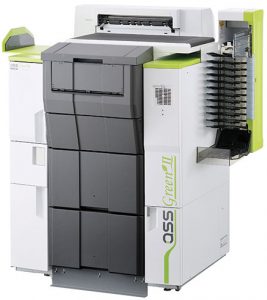
Noritsu also works with popular photo-related apps to make it easy for consumers to find retail print stores and make prints and creative products. “The number of photo apps has exploded, and they’re raising consumers’ awareness of their printing options. This translates into more printed images and the need for printshops and printers that are versatile enough to meet the challenge,” adds Hart.
The shift to cameraphones has changed consumer expectations of the prints they receive. Noritsu printers have multiple profiles. This enables printshops to use one profile to meet the needs of professional photographers, who expect a traditional photo look, and another profile to meet expectations of consumers who are now accustomed to looking at high-contrast mobile device screens.
“The ‘print centric’ model of the past, in which the photo lab was in control of the consumers’ images, has been replaced by the ‘image centric’ model, in which the consumer is in complete control,” says Hart. “However, oftentimes, consumers are overwhelmed by the sheer volume of images they have. In addition, they are unaware of the options available to them. Software and apps are essential. Emerging artificial intelligence, augmented reality and virtual reality technologies will also play a pivotal role. It is critical that these solutions be simple and compelling.”
Mitsubishi Imaging Inc.
Mitsubishi Imaging Inc. (MPM) specializes in printing substrates. The company launched the world’s first microporous instant-dry metallic gloss and luster photo inkjet paper in 2014. The paper addressed the need for a silver halide replacement option. Moreover, the award-winning new media, which has been developed for desktop, wide-format and production dry lab systems using both dye and pigmented ink, has a wider color gamut than silver halide.  MPM complemented these inkjet papers by developing metallic product options for dry toner and liquid ink (HP Indigo) technologies to expand photo reproduction into other print platforms.
MPM complemented these inkjet papers by developing metallic product options for dry toner and liquid ink (HP Indigo) technologies to expand photo reproduction into other print platforms.
“There is a growing market for fine art, photo gifting and personalization,” says Chris Hung, vice president of Sales for Mitsubishi Imaging. “Everything from mugs to large aluminum plate murals to blanket and pillow sets can be made using dye-sublimation papers. Through MPM’s extensive R&D, we’re bringing to market various dye-sublimation products for both hard and soft transfer.
“As the number of cell phone photos captured in digital format continues to grow, along with mobiles apps to support these, the possibilities for outputting in terms of technology and substrates will continue to grow.”
DNP Imagingcomm America Corporation
DNP focuses on software development, kiosk deployment and systems integration for retail as well as event photography. It offers a range of dye-sublimation printers. DNP’s flagship is the DS620A, a compact professional-grade printer that produces up to 400 prints per hour.
The primary goal of DNP is to help retailers and event photographers win and retain both traditional film and digital photo printing customers. The company also strives to make digital photography easy, convenient and fun for consumers.
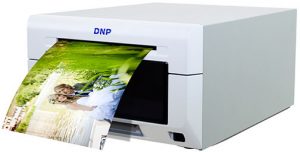
“We have entered an exciting era in photography. It is driven by the availability of steadily improving camera technology integrated into our mobile devices. While more images are being captured, we need to do more to educate consumers about the ways to get these images off of their devices and be able to enjoy them for years to come,” says Katsuyuki Oshima, DNP Imagingcomm America Corporation.
*Expanding the U.S. Photo Printing Market, by F/22 Consulting and Photo Imaging News



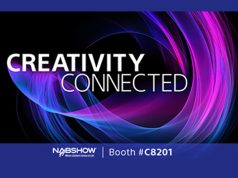


Thanks, Kim, for this excellent article about photo output. As the report that Don and I released so clearly indicates, there is not only growth in photo printing activity, but also major factors in the market that will lift that growth in the months and years ahead. It’s all about innovation, and, of course, economic opportunity!!
Great article, yes the trend of photo printing is booming, let’s what other changes we can see in the coming years.
Fantastic article. In a fast moving sector this is exciting for future technology.